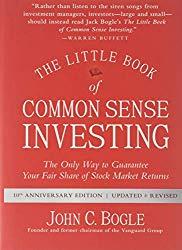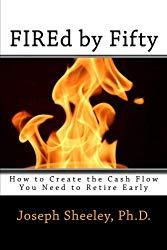In Dollar Cost Averaging (DCA), one invests a fixed amount of money on a regular basis. For example, an investor may put $1000 in a mutual fund every month regardless of market conditions or other factors. This goes on, month after month, year after year. (If you’re interested in starting to invest in mutual funds but don’t know how, check out The Little Book of Common Sense Investing by John Bogle.)
So, why is this better than just dropping $10,000 into a mutual fund and then letting it go? By fixing the amount that is invested and buying regularly, the effect is to buy more shares when the price is relatively low and less shares when the price is relatively high. This causes our average cost per share to be below the average of the price range for the stock over the time period in which we’re investing.

(Note, this site contains affiliate links. When you click on an affiliate link and buy something, The Small Investor will get a small commission for the referral. You are charged nothing extra for the purchase. This helps keep The Small Investor going and free. I don’t recommend any products I do not fully support. If you would like to help but don’t see anything you need, feel free to visit Amazon through this link and buy whatever you wish. The Small Investor will get a small commission when you do, again at no cost to you.)
For example, if we’re putting in $1000 every month, if the shares are trading at $100 per share, we’d get 10 shares. If the price then dropped to $50 per share, we’d get 20 shares – twice as many as we got at the higher price. This means that our cost basis – the average amount that we paid per share and the price above which we start to make a profit – would be about $67 per share. Because we’re buying more shares when the price is low, even if the market stays essentially flat, just moving up and down between a couple of limits, the cost basis for our position will be below the average of the price range, so a profit will be made. If the stock were at $75 in our example, we’d have made $270. If we had just put it the whole $2000 at some random price within the range of $50 to $100, we would have equal chances of having a loss as having a profit at any given time.

If you enjoy The Small Investor and want to support the cause, or you just want to learn how to become financially independent, please consider picking up a copy of my new book, FIREd by Fifty: How to Create the Cash Flow You Need to Retire Early This is the instruction manual on how to become financially independent.
FIREd by Fifty: How to Create the Cash Flow You Need to Retire Early
DCA is a great way to build up a position since it works so well in good markets and bad. If you just dump a lump sum into the market, you’ll have made a profit maybe three out of four ties after a year. After five years, that will go up to maybe eight out of ten times. For ten-year periods, you’ll probably make a profit ninety-eight out of 100 times. If you use DCA, you would have made a profit after every five and ten year periods, and almost every one-year period. In addition, your average profit would be higher than it would be if you just dumped your money in almost every time. This is because the only way that you’ll come out ahead by dumping your money into the market is if you are lucky enough to hit the low point for the period when you buy in at the start of the period, which happens fairly rarely. It is much more common for stock prices to meander around and then suddenly shoot up over a period of a couple of weeks to a month, resetting the level before meandering again.
DCA is a very automated, easy, no-decision way of investing and is a good approach. It can also be improved upon, however. Looking at the chart for any stock or the markets in general if investing in mutual fudns, one sees that the price tends to increase for periods, then decrease for periods. For a stock that is growing (the kind recommended here), the lows will always be higher than the previous lows, and the highs higher than the previous highs – this is called an “uptrend”. Because the stock does not move randomly, as it falls in price it becomes more and more likely that it will stop falling and move upwards again (again, we’re talking about stocks that over the long-term are growing). The modification to the dollar cost averaging strategy is then to wait for periods where the stock has fallen in price before making investments. In doing so, a better price will be gained than that gained through blind averaging.
Choosing when to buy in this method is somewhat arbitrary. One could buy when the price falls for three days in a row, or when the price drops by 10% or so. Obviously, a method should be chosen such that the stock can be bought regularly. Waiting for the price to drop by 20%, say, before making a purchase, may result in few shares actually being purchased while the stock climbs to the sky, leaving you behind.

Want all the details on using Investing to grow financially Independent? Try The SmallIvy Book of Investing.
DCA is also a good strategy when acquiring individual stocks. In fact, it is probably more important since individual stocks tend to move around a lot more in price than mutual funds, so you are much more likely to see your investment down 20 or 30% if you just dump money into a stock than you are if you do so with a mutual fund. To have a 30% loss on a mutual fund, the whole market needs to drop. To see it with an individual stock, the company just needs to miss earning expectations or there just need to be a few people who are overeager to buy shares and drive the price up too high in too short a time period. This is why I recommend selecting a few stocks to keep on a watch list, then buying a hundred or two hundred shares at a time of whatever stock is down and a good value relative to its usual price range (in other words, has a PE that is on the low side of its normal range.) This is done until a sizeable position of 500 to 1000 shares, or whatever amount of money you are able to withstand losing, is invested. More details on this strategy can be found in The SmallIvy Book of Investing.
Have a burning investing question you’d like answered? Please send to [email protected] or leave in a comment.
Follow on Twitter to get news about new articles. @SmallIvy_SI
Disclaimer: This blog is not meant to give financial planning or tax advice. It gives general information on investment strategy, picking stocks, and generally managing money to build wealth. It is not a solicitation to buy or sell stocks or any security. Financial planning advice should be sought from a certified financial planner, which the author is not. Tax advice should be sought from a CPA. All investments involve risk and the reader as urged to consider risks carefully and seek the advice of experts if needed before investing.
